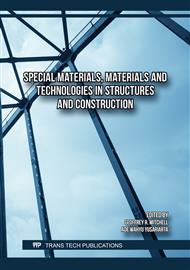[1]
Y. Su, G. Fu, B. Wan, T. Yu, W. Zhou, and X. Wang, "Fatigue reliability design for metal dual inline packages under random vibration based on response surface method," Microelectron. Reliab., vol. 100–101, no. July, p.113404, 2019.
DOI: 10.1016/j.microrel.2019.113404
Google Scholar
[2]
T. Y. Tee, H. S. Ng, Z. Zhong, and J. Zhou, "Board-level solder joint reliability analysis of thermally enhanced BGAs and LGAs," IEEE Trans. Adv. Packag., vol. 29, no. 2, p.284–290, 2006.
DOI: 10.1109/TADVP.2006.874699
Google Scholar
[3]
T. Y. Park, S. J. Shin, and H. U. Oh, "New version of high-damping pcb with multi-layered viscous lamina," Aerospace, vol. 8, no. 8, 2021.
DOI: 10.3390/aerospace8080202
Google Scholar
[4]
Z. Liu, Y. Sun, and X. Sun, "Fatigue life prediction model for PCB under random vibration," 2017 2nd Int. Conf. Syst. Reliab. Safety, ICSRS 2017, vol. 2018-Janua, p.232–237, 2018.
DOI: 10.1109/ICSRS.2017.8272827
Google Scholar
[5]
R. A. Amy, G. S. Aglietti, and G. Richardson, "Accuracy of simplified printed circuit board finite element models," Microelectron. Reliab., vol. 50, no. 1, p.86–97, 2010.
DOI: 10.1016/j.microrel.2009.09.001
Google Scholar
[6]
J. Gu, D. Barker, and M. Pecht, "Prognostics implementation of electronics under vibration loading," Microelectron. Reliab., vol. 47, no. 12, p.1849–1856, 2007.
DOI: 10.1016/j.microrel.2007.02.015
Google Scholar
[7]
F. Liu, Y. Lu, Z. Wang, and Z. Zhang, "Numerical simulation and fatigue life estimation of BGA packages under random vibration loading," Microelectron. Reliab., vol. 55, no. 12, p.2777–2785, 2015.
DOI: 10.1016/j.microrel.2015.08.006
Google Scholar
[8]
Y. Jiang, J. Y. Tao, Y. A. Zhang, and G. J. Yun, "Fatigue life prediction model for accelerated testing of electronic components under non-Gaussian random vibration excitations," Microelectron. Reliab., vol. 64, p.120–124, 2016.
DOI: 10.1016/j.microrel.2016.07.018
Google Scholar
[9]
M. I. L-std- and S. Mil-std-, "Department of Defense Test Method Standard Environmental Engineering Considerations and Laboratory Tests," Mil-Std-810G, no. October, p.804, 2008.
DOI: 10.17764/jiet.44.3.f45015p217843r36
Google Scholar
[10]
H. W. Zhang, Y. Liu, J. Wang, and F. L. Sun, "Effect of elevated temperature on PCB responses and solder interconnect reliability under vibration loading," Microelectron. Reliab., vol. 55, no. 11, p.2391–2395, 2015.
DOI: 10.1016/j.microrel.2015.07.033
Google Scholar
[11]
P. Marjamäki, T. T. Mattila, and J. K. Kivilahti, "A comparative study of the failure mechanisms encountered in drop and large amplitude vibration tests," Proc. - Electron. Components Technol. Conf., vol. 2006, p.95–101, 2006.
DOI: 10.1109/ECTC.2006.1645631
Google Scholar
[12]
J. S. Karppinen, J. Li, and M. Paulasto-Kröckel, "The effects of concurrent power and vibration loads on the reliability of board-level interconnections in power electronic assemblies," IEEE Trans. Device Mater. Reliab., vol. 13, no. 1, p.167–176, 2013.
DOI: 10.1109/TDMR.2012.2226462
Google Scholar
[13]
F. Xu, C. R. Li, T. M. Jiang, and D. P. Zhang, "Fatigue Life Prediction for PBGA under Random Vibration Using Updated Finite Element Models," Exp. Tech., vol. 40, no. 5, p.1421–1435, 2016.
DOI: 10.1007/s40799-016-0141-6
Google Scholar
[14]
D. Yu, A. Al-Yafawi, T. T. Nguyen, S. Park, and S. Chung, "High-cycle fatigue life prediction for Pb-free BGA under random vibration loading," Microelectron. Reliab., vol. 51, no. 3, p.649–656, 2011.
DOI: 10.1016/j.microrel.2010.10.003
Google Scholar
[15]
V. N. Somashekar, S. Harikrishnan, P. S. M. Aejaz Ahmed, and D. Kamesh, "Vibration Response Prediction of the Printed Circuit Boards Using Experimentally Validated Finite Element Model," Procedia Eng., vol. 144, p.576–583, 2016.
DOI: 10.1016/j.proeng.2016.05.044
Google Scholar
[16]
Y. Nakagawa and R. Yokoyama, "Optimum design of printed circuit board to reduce deformation in reflow process by a global optimization method," Mater. Des., vol. 33, no. 1, p.164–174, 2012.
DOI: 10.1016/j.matdes.2011.07.043
Google Scholar
[17]
I. Szendiuch, B. Psota, A. Otahal, and M. Klapka, "Importance of vibration testing for new technological configurations in electronics," EMPC 2013 - Eur. Microelectron. Packag. Conf. Wind. Roads Electron. Packag., 2013.
Google Scholar
[18]
F. Liu and R. Fan, "Experimental modal analysis and random vibration simulation of Printed Circuit Board assembly," Adv. Vib. Eng., vol. 12, no. 5, p.489–498, 2013.
Google Scholar
[19]
Y. An, N. O. T. Measurement, M. I. L-std-, and S. Mil-std-, "Department of Defense Test Method Standard Environmental Engineering Considerations and Laboratory Tests," Mil-Std-810G, vol. 2, no. October, p.804, 2008.
DOI: 10.17764/jiet.44.3.f45015p217843r36
Google Scholar


